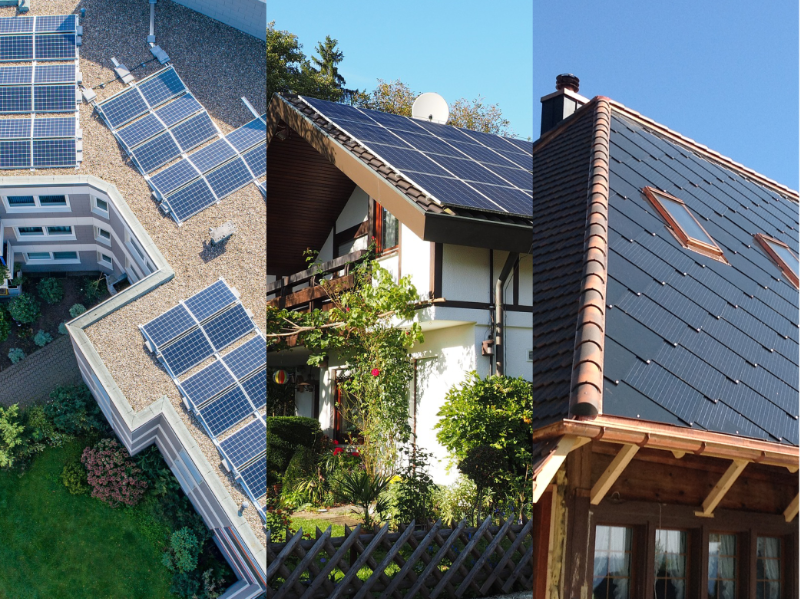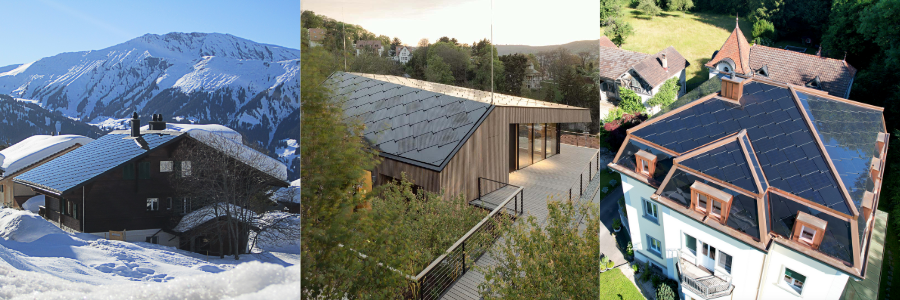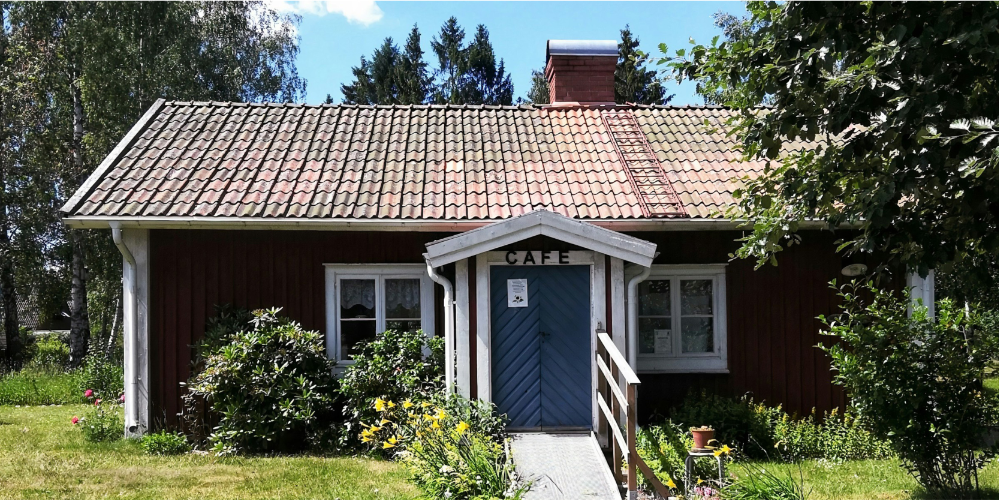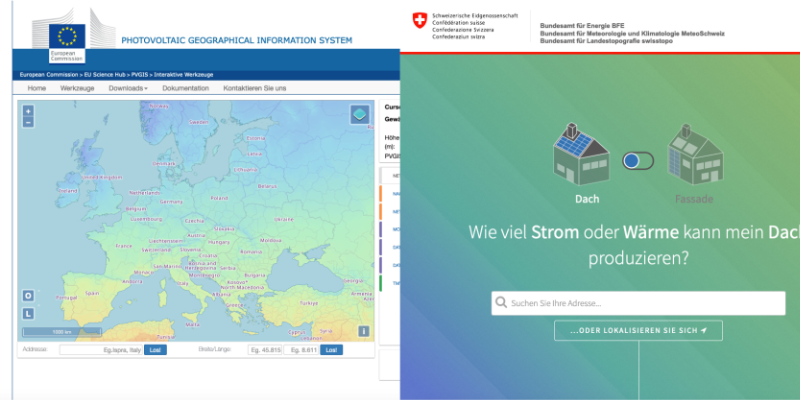In these times, every homeowner is asking themselves whether and which solar energy system they need for their home. With these 5 questions, you will know quickly and reliably which solution is best for you, whether a solar system makes sense for your home at all and what else needs to be considered.
Roof type: What kind of house is it?

Source: SunStyle, Unsplash and pixabay
There are different solutions for solar systems depending on the type of roof:
- Many modern buildings have a flat roof. On a flat roof, solar modules are mounted in several rows on a substructure. The number of modules can vary depending on the orientation of the building and the space available. The entire construction must be secured against high wind forces by anchoring or ballasting. It is crucial to consider the maximum permissible load of the roof.
- As ballasting is not possible on sloping surfaces, the substructure must be mechanically mounted on a pitched roof. The installation is therefore bolted to the roof or sub-roof to ensure secure and permanent attachment. The same solar modules are often installed here as on a flat roof and this is referred to as a rooftop system.
- Another option is to integrate the solar system directly into the roof. In this case, the solar modules not only produce electricity, but also fulfil the protective function of tiles. This method is not only ecological, but also aesthetically pleasing, as the PV system is seamlessly integrated into the roof structure. This is a so-called in-roof system (BIPV = building integrated photovoltaics).

Source: SunStyle
Roof age: How old is my (tiled) roof?

Source: Unsplash
The best time to install a solar energy system is now. However, the choice of a suitable solar system depends on various factors, such as the year of construction of the building.
It is generally always possible to install a system on empty flat roofs.
Both flat roofs and pitched roofs can retain their functionality for up to 50 years or even longer if properly maintained. The quality of the clay tiles used plays a decisive role here, as individual tiles can become brittle and fragile over time due to the effects of weather and sunlight. Even a relatively new roof can be damaged by unusually heavy hail, especially in view of the increasing frequency of extreme weather events.
If a pitched roof needs to be completely or partially renovated, it is advisable to consider the use of an in-roof system. These replace conventional tiles with thick glass panes, which are more resistant to hail damage than older clay tiles.
Orientation and surroundings: Is your roof on the sunny side?
The orientation of the building in relation to the sun’s path and the immediate surroundings are important aspects in terms of the performance and energy yield of a solar installation.
For flat roofs, the orientation does not play a significant role, as the solar panels are mounted by the installer in such a way that they are optimised for the homeowner’s own consumption. Areas that are orientated as far south as possible normally produce the highest energy yield.
The situation is somewhat more complex with a pitched roof: The optimum orientation of a roof surface is south-facing in order to maximise solar radiation. East-west roofs are also possible, as you can utilise both the morning sun and the evening sun effectively. With intelligent building control, electricity-intensive household appliances such as washing machines or dishwashers can be operated in the morning or evening hours (more information on self-consumption below). Depending on the pitch of the roof, even north-facing roofs can be profitable nowadays, but an energy consultant should be consulted in advance on this topic.
Roof surface: A barn roof the size of a football pitch or a complex city roof?
Not every roof surface is ideal for the installation of solar energy systems. Rooftop systems in particular require as large an area as possible without obstacles. If there is a skylight, chimneys and different roof pitches, the usually large solar modules cannot be installed in sufficient numbers. This is where in-roof systems have a major advantage, as they can make the most of any roof shape, even with complicated roof surfaces.
Interested homeowners can use online tools to find out within a very short time whether their own roof is suitable for photovoltaics or even create an independent yield forecast.

Source: PVGIS and sonnendach.ch
Germany
The solar energy potential registers available in Germany are collected and linked at www.solare-stadt.de. In just a few clicks, users can find their roof and find out how high the solar radiation potential is.
Example: You live in the Windberg district in the north of Monchengladbach. You select your town on the map or in the list and then click on “To the solar potential register”. After clicking on the solar potential catastar again, you will be taken to an interactive map where you can enter your address or search for your house manually. You will now be shown how much solar radiation is available on your roof and how much area can be used to generate electricity.
If your area is not active on the map, you can use PVGIS (see below) to determine the yield at your address.
Switzerland
The Swiss Federal Office of Energy (SFOE) provides an online suitability map on which interested parties can analyse the roof or facade of their own building with just a few clicks: Link to the suitability map
The map shows all roofs in Switzerland and rates them using a colour system. Blue areas are only partially suitable for the use of solar energy, while orange to red areas have great potential for solar energy. The website provides homeowners with lots of useful information for the possible installation of a solar system.
European Union
With PVGIS, the European Commission has been providing a free tool for determining the yield of solar installations at no charge for years. PVGIS contains comprehensive data and measurements of global solar radiation. You can obtain a rough yield estimate by entering three important pieces of data.
Minimum input required:
- Location: Enter your home address or the address of the property. Or select the building on the map.
- Roof pitch: Enter the approximate “Pitch [°]” of the roof. 30° is the average pitch of a pitched roof.
- Orientation: Enter the orientation of the building in the “Azimuth [°]” field. 0° is south, -90° is east and 90° is west. So if the roof of the house faces south-west, enter the value 45°.
PVGIS is a powerful and helpful tool, but requires a certain amount of practice to use correctly.
Self-consumption: Who needs the electricity and when?
A decisive factor when considering whether a solar energy system makes sense is self-consumption. Self-consumption refers to the use of the solar power generated directly in your own household instead of feeding it into the grid. This can bring considerable financial benefits.
What counts as own consumption?
Self-consumption includes the electricity generated by your own solar system and used directly in your home. This can be the operation of small electrical appliances, lighting or electricity-intensive consumers. The higher the level of self-production, the less dependent the household is on external energy sources.
Smart home for intelligent self-consumption
The integration of smart home technologies enables precise control of energy consumption in the home. Intelligent systems can optimise the operation of electrical appliances in order to make the best possible use of the solar power generated. For example, washing machines, dishwashers or charging stations for electric vehicles can be programmed to be active during sunny days or hours. This case study explains in detail how an intelligent energy manager affects self-consumption and thus directly influences the amortisation period of the entire solar system.
Power storage as support
To further maximise self-consumption, the installation of an electricity storage system can be considered. A storage system enables the temporary storage of surplus solar power, which can then be utilised during periods of low solar radiation. In this way, independence from the grid is increased and the solar power generated is utilised more efficiently.
Overall, self-consumption plays a key role when it comes to maximising the benefits of a solar installation. Smart home technologies and electricity storage systems can help to optimise self-consumption and increase the cost-effectiveness of the solar system.
Conclusion
Various factors play a role in the decision to install a solar system, from the type and age of the roof to the orientation, surroundings and self-consumption. A detailed understanding of these aspects enables homeowners to find the best possible solar solution for their needs. The use of smart home technologies and the installation of an electricity storage system help to optimise self-consumption and increase the profitability of the solar system.
If you would like to find out more about the benefits of an in-roof solar system, you can find more information here:
If you would like to know how an in-roof solar system can be customised specifically to your roof, please do not hesitate to contact us for more information. Our team will be happy to answer your questions and discuss customised solutions for your solar-powered energy needs. Contact us today for a customised consultation.
For more information about SunStyle’s solar roof, visit sunstyle.com
Power your interest in the future of solar roofing by following us:
Instagram @sunstyle_solar
Facebook @sunstylesolar
LinkedIn linkedin.com/company/sunstylesolar
Youtube @youtube channel


